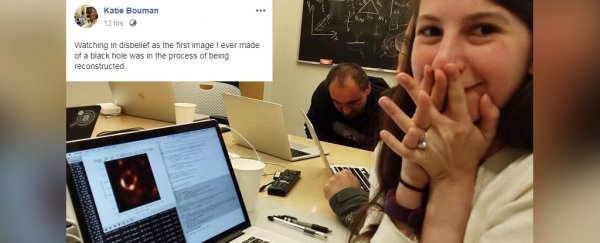Katherine Bouman had a secret: An algorithm she'd developed had stitched together a picture of a black hole. She told nobody except her colleagues. Until today. That's when Event Horizon Telescope team, of which Bouman is a member, unveiled the first image of a black hole.
Bouman, 29, a postdoctoral researcher at the Harvard-Smithsonian Center for Astrophysics, had been working on such an algorithm for almost six years, since she was a graduate student at MIT.
She was one of about three dozen computer scientists who used algorithms to process data gathered by the Event Horizon Telescope project, a worldwide collaboration of astronomers, engineers and mathematicians.
Telescopes around the world collected high-frequency radio waves from the vicinity of Messier 87 (M87), a galaxy with a supermassive black hole 54 million light-years away.
But atmospheric disturbance and the spareness of the measurements meant "an infinite number of possible images" could explain the data, Bouman said. Well-designed algorithms had to crunch through the chaos.
The image shared Wednesday, which has been likened to a molten doughnut or the Eye of Sauron or even a Rembrandt, is a composite of several such reconstructions.
"We blurred two of the images and then averaged them to the other one to get the image that we showed today," Bouman said. The ring of material that surrounds M87*, which has the mass of 6.5 billion suns, "is something that we were incredibly confident about."
Take your rightful seat in history, Dr. Bouman! 🔭
— Alexandria Ocasio-Cortez (@AOC) April 10, 2019
Congratulations and thank you for your enormous contribution to the advancements of science and mankind.
Here’s to #WomenInSTEM!
👩🏻🔬👩🏾💻👩🏼🏭👩🏿🏫 https://t.co/3cs9QYrz9C
The Washington Post spoke with Bouman after the picture was unveiled. The following is lightly edited for clarity.
Q: You're not an astronomer. So how did you get involved with taking a picture of a black hole?
A: I come from a computer science and electrical engineering background. I did my PhD in a computer vision group, where you try to understand images. And I heard about this project, this idea of imaging black holes.
At the time I hardly even knew what a black hole was. But I tagged along to this meeting [where Shep Doeleman, the Harvard University astronomer who directs the Event Horizon Telescope project, was discussing black holes]. I had no idea what he was talking about, but when I left that meeting I knew that this is something that I wanted to work on.
I have an interest in how can we see things or measure things that are thought to be invisible to us. And how can we come up with unique ways to merge the instrumentation and algorithms to get at measuring things that you can't measure with standard instruments.
Q: What was the algorithm's role for this image, stitching together data from telescopes across the planet?
A: We have telescopes distributed around the world. For every two telescopes in the telescope array, we measure a single spatial frequency, which tells you something about like how fast things are changing.
We get this partial information. It's almost like seeing one pixel in an image (but it's in a different kind of domain). We have to come up with methods that take this really sparse, really noisy data, and try to find the image that might have caused those measurements.
What we have to end up doing is imposing things called "regularizors" or "priors" that allow us to say, "Okay, of all of the images that possibly could fit this data, this set of images is most likely."
But the danger is we don't want to inject additional information into the problem, so as to bias our result toward something that we would expect to see. We have spent an enormous amount of time making sure that what we were seeing was actually real and not just something that, even subconsciously, we might have imposed on the data.
[To remove the possibility of bias shared by the entire team, the project split its computer-imaging experts into four different groups, each working on a different sort of algorithm. They were not allowed to communicate.]
Q: When did you know the black hole was, well, a hole?
A: We were confident, at least, that we were seeing this ring-like feature. Still, we didn't know that other teams would get the same result.
We all got together in a meeting in Cambridge Massachusetts, and on the second day of the meeting, we all revealed what picture we had reconstructed from the data. It was probably the most exciting moment I've ever had with the project.
When I saw that we all had reconstructed this ring, then I knew that it was an incredibly robust feature.
[For months afterward, the computer scientists tried to break their images. They developed new scripts or pipelines and trained those pipelines on data for discs; these astronomical structures don't have any holes. But when the scientists fed the real telescope data back through the pipelines developed for discs, they reconstructed a ring. The feature existed.]
We didn't get a disc. We still got that hole.
2019 © The Washington Post
This article was originally published by The Washington Post.
